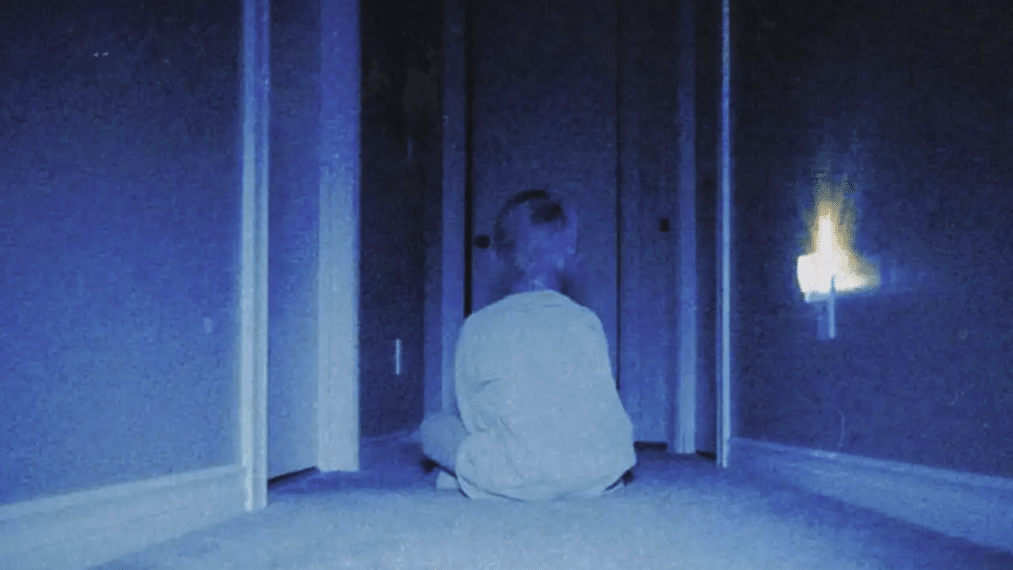Skinamarink is the little grassroots horror that could. With a highly experimental visual style and a shoestring narrative to match its shoestring budget, this haunted house film has audiences abuzz the world over. And yet …
It is obtusely, audaciously boring. The overall tone is one of a child very slowly describing a nightmare that clearly frightened him, without being able to convey anything tangibly scary.
I can only recommend watching the whole thing if you have the sort of friends who’ll diligently quiz you on having kept up with the trendiest new films. Aficionados advise watching it in the dark without distractions, because if you blink for a moment you’ll miss the handful of significant moments.
The hotly-contested use of digitally-added film grain is arguably beneficial, because it confirms that your Shudder stream hasn’t simply frozen. This is often the only hint that anything has happened for 20 minutes at a time. With only prolonged grainy shots of furniture, never revealing a character’s face, it’s difficult to grasp any of the relationships, setting, or suspense.
If you look away you might miss the vague clues of mumbled dialogue that suggest each shot is somehow connected to the last. Don’t catch yourself thinking you’re not clever enough to follow it, or that a Skinamarink Explained breakdown will offer an authoritative interpretation: the loose and dreamlike snatches of action truly have that little to offer.
Paint by numbers
Unfortunately, beside the radically obtuse cinematography, the film relies on paint-by-numbers horror conventions. The defiance of continuity editing pays homage to Un Chien Andalou. A dash of Poltergeist as the children watch TV compulsively. A heavy dose of Paranormal Activity while you patiently await bumps in the night. A vague influence from Hereditary, where indiscriminate use of smash cuts substitutes the strategic tension of a jump scare. A fleeting allusion to House of Leaves as the architecture spontaneously warps. Some grotesquery lifted straight from Ringu to the point of legal ambiguity. It generously features early-1900s animation from Fleischer Studios, whose distinctively contorted shorts do much of the heavy lifting in both dispelling and building suspense. These tired tropes undercut much of the appeal found in Skinamarink’s idiosyncratic visuals.
In a rare snatch of exposition, Skinamarink reveals the true spectre haunting the family is divorce: this detail drags the entire premise down, turning the paranormal into an exhausted Freudian metaphor. It seems to suggest that a haunted house is not sufficiently scary, compared to a nuclear family breakup in the 1990s. The broken family B-plot might work better if the film had an A-plot to speak of.
Internet horror
While there are plentiful pitfalls from cinema history, Skinamarink’s aesthetic owes more to internet horror. It’s a format that can be wildly effective, as seen with the viral success of the Slender Man, SCP, and Reddit’s Two-Sentence Horror, but more often internet horror is excruciatingly cringeworthy. Skinamarink features a discordantly gory scene that recalls those chain emails in the 1990s about a girl with no eyes, presented with the pacing of an old ‘jumper’ internet prank like the Scary Maze Game. Knowing the director has a YouTube channel where he makes abstract films out of nightmares described to him by commenters, Skinamarink makes some sense.
It’s evident Skinamarink would have made a very effective eight-minute short, without sacrificing the signature tedium. It’s brazen in how dull it is: if you enjoy boredom as a device to build anticipation, you’ll be delighted. But when the ghostly entity whispers ‘go to sleep,’ it becomes difficult not to do just that. The monotony and the haphazard framing are obvious rhetorical devices, but that doesn’t mean they justify themselves at 100 minutes.
The minimalism is sometimes praiseworthy: superglue and napoli sauce make up the effects budget. The most intense scare is a sudden shot of a toy telephone. It has its horror hallmarks: the poltergeist wants to play a game; it speaks exclusively to children; the parents are preoccupied by their own problems; the kids have quote-ably twee voices. These, and the prefabricated elitism of insisting that other audiences simply did not appreciate it, will likely canonise Skinamarink as a cult favourite.
It’s at least worth celebrating such an experimental project gaining global attention. That’s not to say the experiment is successful as a film worth watching, but in a market of increasingly homogenised blockbusters – which are often just as visually murky and narratively nonsensical – it’s fantastic to see that audiences will embrace difficult movies. If it opens up opportunities for new films willing to break the mould, they can only be more entertaining than Skinamarink.
Viewers should be warned that there are intense flashing scenes that could trigger epilepsy.
Actors:
Director:
Format: Movie
Country:
Release:





